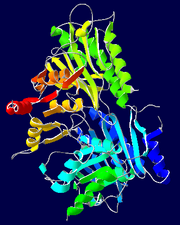Fructose-1,6-bisphosphatase deficiency
Fructose bisphosphatase (EC 3.1.3.11) is an enzyme in the liver, that converts fructose-1,6-bisphosphate to fructose-6-phosphate in gluconeogenesis (the making of glucose from smaller substrates). Fructose bisphosphatase does the opposite job to phosphofructokinase, and both these enzymes only work in one direction. more...
Fructose bisphosphatase deficiency
If there is a deficiency in fructose bisphosphatase, gluconeogenesis will not occur correctly. Glycolysis (the break-down of glucose) will still work, as this does not use this enzyme.
Without effective gluconeogenesis (GNG), hypoglycaemia will set in after about 12 hours. This is the time when liver glycogen stores have been exhausted, and the body has to rely on GNG. When given a dose of glucagon (which would normally increase blood glucose) nothing will happen, as stores are depleted and GNG doesn't work. (In fact, the patient would already have high glucagon levels.)
There is no problem with the metabolism of glucose or galactose, but fructose and glycerol cannot be used as fuels. If fructose or glycerol are given, there will be a build up of phophorylated three-carbon sugars. This leads to phosphate depletion within the cells, and also in the blood. Without phosphate, ATP cannot be made, and many cell processes cannot occur.
High levels of glucagon will tend to release fatty acids from adipose tissue, and this will combine with glycerol that cannot be used in the liver, to make triacylglycerides causing a fatty liver.
As three carbon molecules cannot be used to make glucose, the will instead be made into pyruvate and lactate. These acids cause a drop in the pH of the blood (a metabolic acidosis). Acetyl CoA (acetyl co-enzyme A) will also build up, leading to the creation of ketone bodies.
To treat people with a deficiency of this enzyme, they must avoid needing gluconeogenesis to make glucose. This can be accomplished by not fasting for long periods, and eating high-carbohydrate food. They should avoid fructose containing foods (as well as sucrose which breaks down to fructose).
As with all single-gene metabolic disorders, there is always hope for genetic therapy, inserting a healthy copy of the gene into existing liver cells.
Read more at Wikipedia.org



